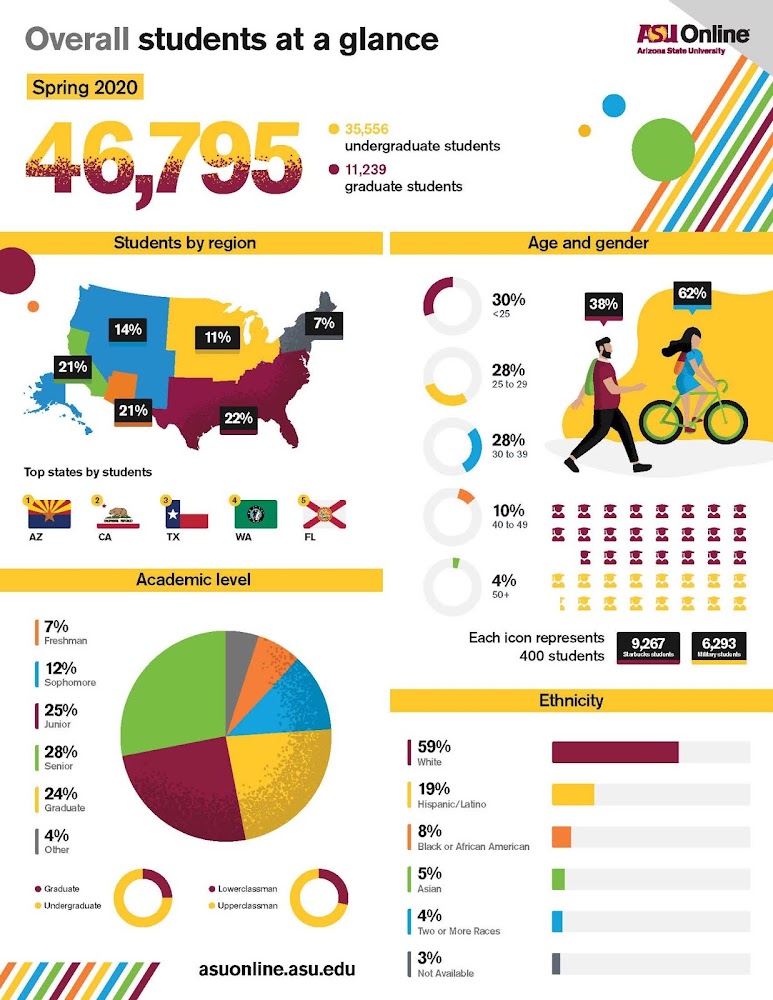As instructors, we make hundreds of decisions throughout a semester as we interact with our students, explain concepts and procedures, or assess their knowledge and skills. To help us make choices - among other important factors - understanding the characteristics and needs of learners is fundamental to designing effective and efficient learning experiences. For example, as parents can tell you, there is quite the difference on how one would explain a certain concept to a 5-year-old versus someone who is in his late thirties! In addition to age, other characteristics play important parts, such as location, language, background, etc. Hence, familiarity of fundamental facts pertaining to the learner population can significantly support the learning effectiveness, efficiency, as well as the engagement.
Over the past decade, the learner population of ASU Online has seen significant growth. What started with a few hundred enrolled students at the beginning of the decade has grown exponentially to over 45,000 learners in Spring 2020. While these numbers are impressive, do we really know who is attending our courses?
So, what does this mean for us instructors? Understanding our audience is key. It informs us as we present content, make references, provide feedback, etc. Understanding that our audience is changing is very important as well (see Marist's Mindset List). As populations change, characteristics and experiences that previously helped us make decisions might need to be reconsidered to ensure effectiveness in our instructions. It is vital to continuously reflect on who we are teaching as well as what we are teaching! Considering that these data sets were collected before the COVID pandemic, it will be interesting to see its impact on the ASU Online learner population.
Post author:
Peter van Leusen, Ph.D., is the Director of Learning Experience for EdPlus at Arizona State University. In this role, he collaborates closely with departments and faculty on student success initiatives across diverse modalities and disciplines. His recent projects focused collaborating on adaptive curriculum and courseware development, designing MOOCs in a foreign language, and spearheading innovative digital educational experiences for broad audiences.
Over the past decade, the learner population of ASU Online has seen significant growth. What started with a few hundred enrolled students at the beginning of the decade has grown exponentially to over 45,000 learners in Spring 2020. While these numbers are impressive, do we really know who is attending our courses?
So, what does this mean for us instructors? Understanding our audience is key. It informs us as we present content, make references, provide feedback, etc. Understanding that our audience is changing is very important as well (see Marist's Mindset List). As populations change, characteristics and experiences that previously helped us make decisions might need to be reconsidered to ensure effectiveness in our instructions. It is vital to continuously reflect on who we are teaching as well as what we are teaching! Considering that these data sets were collected before the COVID pandemic, it will be interesting to see its impact on the ASU Online learner population.
The goal of this article is to develop an understanding of the ASU Online learner population as well as set a benchmark with pre-COVID data (Spring 2020). Once updated data sets are available, the intentions are to share those and identify potential changes which might be related to recent developments.
Post author:
Peter van Leusen, Ph.D., is the Director of Learning Experience for EdPlus at Arizona State University. In this role, he collaborates closely with departments and faculty on student success initiatives across diverse modalities and disciplines. His recent projects focused collaborating on adaptive curriculum and courseware development, designing MOOCs in a foreign language, and spearheading innovative digital educational experiences for broad audiences.


Comments
Post a Comment